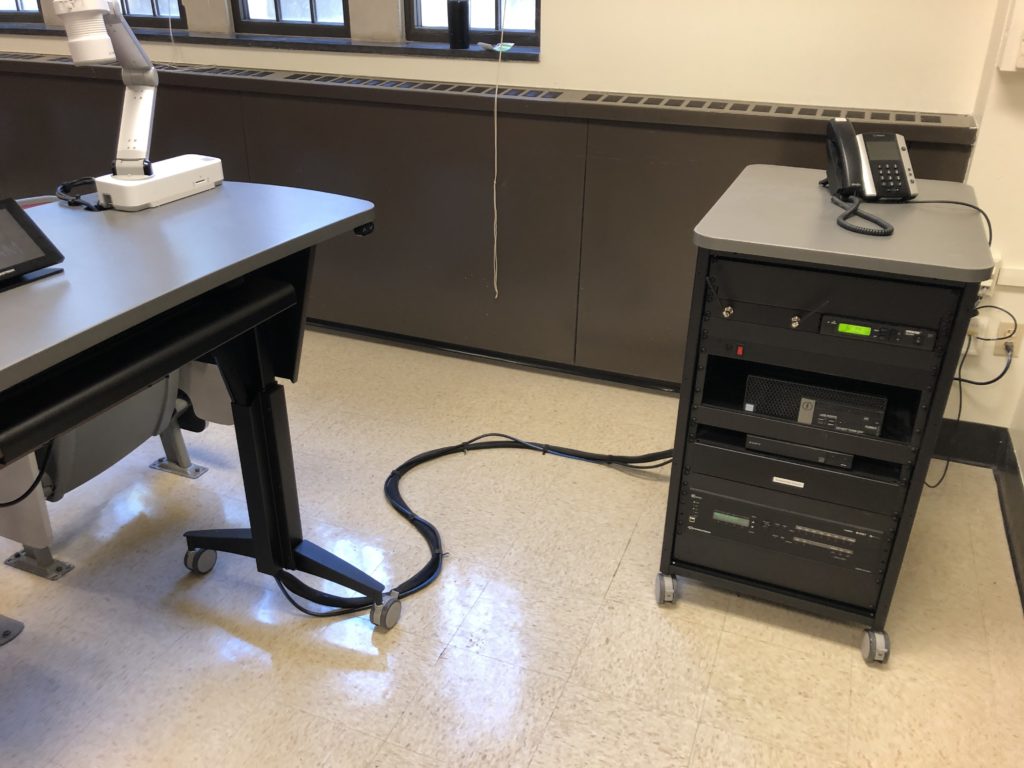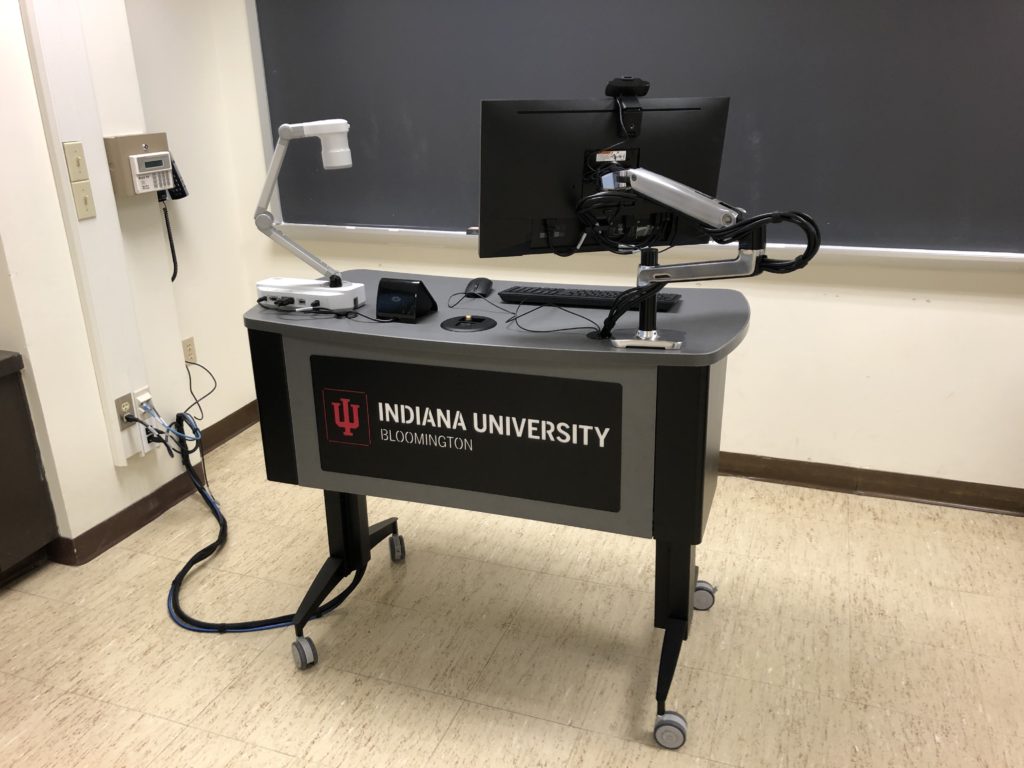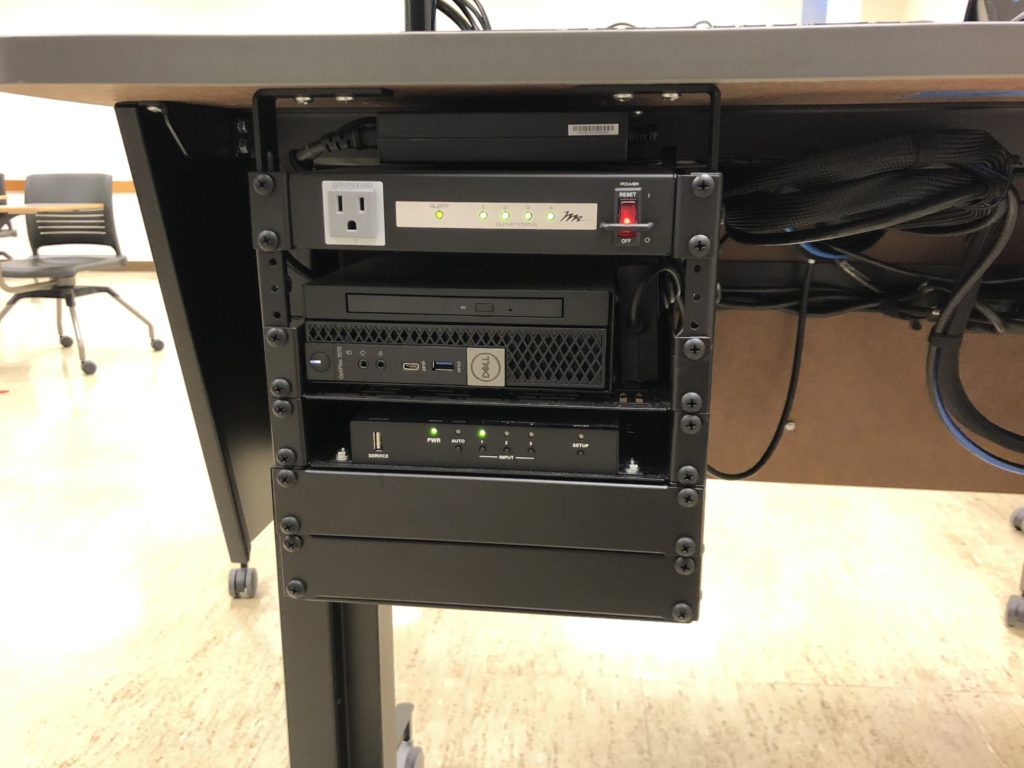Furniture isn’t often thought of as technology infrastructure, but in classrooms, furniture can be just as important to a successful learning environment as the network connections, video displays, and microphones. Learning spaces include more and more technology each year — even before COVID-19 — and as few learning spaces provide a dedicated space for large AV & IT equipment racks, technology must live wherever possible within the space itself, be it mounted to the underside of tables, tucked inside lecterns, wedged behind monitors, and even hidden in the floor and ceiling.
But, what is technology-enabled furniture? For this discussion, we’ll define it as furniture purpose-built to provide dedicated and permanent locations for technology critical to the operation of the learning space. This technology can include everything from video displays to speakers to AV transmitters and receivers to network and power connections — not to mention the myriad of associated cables, adapters, and power supplies necessary to make it all work.
As university AV & IT experts, we’re not the usual suspects when it comes to selecting technology-enabled furniture, but in many respects, we’re the true end-users of the furniture; students and teachers are just borrowing it for an hour or so each day. We’re the team who has to care for and maintain the furniture and the critical technology connected to it.
However, technology-enabled furniture is a very large topic that can’t be discussed fully in a single article, so we’ve divided furniture into four categories: lecterns and teaching stations, student tables, conference room furniture, and furniture in huddle spaces and informal learning spaces. We’ll devote an article to each in future issues.
In order to detail what makes furniture successful in learning spaces and what requires extensive modification or even replacement by on-site IT staff, we’ve identified five criteria for evaluating technology-enabled furniture: standardized connections, mounting options, cable routing, field serviceability, and ADA compliance.

Standardized connections can refer to any integrated power and data connections as well as multi-input device connections. Cabling and connectors must be, above all, non-proprietary. If furniture has a device for student or teacher technology (laptops, tablets, and smartphones) to connect—be it a flip-top recessed box, a pop-up column, or an edge-mounted device, it must use standard-sized inserts such as keystone, Decora (aka decorator), D-series (aka D-style or D-type), or switchbox gang sizes. Additionally, user-selected devices can be accommodated at the factory or field-modified to meet existing institutional standards. Most schools have a preferred manufacturer for AV table devices and their local IT staff would love to have those mounting locations pre-cut for quick installation. Proprietary table devices will often be removed, the furniture top surface re-cut, and preferred devices installed in their place.
AV equipment mounting locations should be easily accessible for installation and continued maintenance and should ideally use standardized 19” or 10.5” telecommunication equipment rack rail systems. Even better, multiple rack rail options and accessories are much appreciated by the local IT staff. The underside of furniture should provide plenty of space free of structural members and supports to allow mounting of non-rackable equipment or for installations requiring only a few pieces of equipment. Designated AV equipment locations are ideally not limited only to a small area inside an integrated cabinet or box, as those often do not provide enough open ventilation. Decorative shrouds, trim panels, valances, or modesty panels should be quickly and easily removable. There are times when additional equipment security may be necessary and in those rare instances, a sealed or locking cabinet can be a nice option, but it shouldn’t be the default.
lecterns and teaching stations are truly the heart of a classroom, both from an operational as well as a technology perspective.
Cable routing includes both high voltage power connections as well as raceway locations for user-installed low-voltage cabling. High voltage power connections integrated power distribution units should be connected via replaceable IEC C320 cables of user-selected length. This allows for cleaner cable dressing and reduced EMF interference with nearby unshielded low voltage cables. Low voltage cables will be bundled and loomed during installation by local IT staff. For furniture with legs, dedicated cable pathways attached to a leg on each side provides an ideal method for running cables to an adjacent floor box or wall box.
Field serviceability can be considered a function of time and force. Time, in the sense of how long it takes to remove, modify, and reattach a panel or section from a furniture product. Force, in the sense of how much the local-IT team has to apply to remove and reattach said panel. Furniture should use standardized hardware that can be easily manipulated in the field with basic hand tools. Specialized clips—especially plastic—will invariably be bent or broken while installing technology equipment. Consider easily detachable panels that can be swapped in and out for technology upgrades or maintenance. Multiple modular panels would be even better.
ADA is a critical part of educational technology, and furniture should be fully compliant. Work surfaces should be height adjustable when possible as well as provide sufficient space for a wheelchair to roll under the surface. This is one of the primary reasons that keyboard trays get removed immediately as they can unnecessarily limit the access for wheelchair users. Flexible computer monitor arms are a great solution to allow smaller displays to be manipulated for better viewing. Ideally, the entire work surface should be ADA compliant as the smaller, flip-up shelf surfaces are not preferable.
There is an inherent balance between form and function, but in education, function wins every time, especially when considering classroom equipment that will be used directly by teachers and students. If furniture can meet all the criteria above and still look fabulous, then that’s great for everyone. However, if furniture compromises functionality to look fabulous, then allow us to let you in on a dirty little secret of local IT staff when it comes time to install technology—we have power tools and are not afraid to use them. The number of lecterns, tables, and credenzas that we’ve drilled, sawed, and cut would surprise you. If we can avoid doing that, particularly if we’re doing so to replace or modify a device insert, mounting bracket, or similar attached accessory, all the better.

Now, with all that said, onward to lecterns and teaching stations. The teaching station is functionally the center of the classroom technology system. It’s the home base to where teachers can periodically return during a class, the landing zone for their class teaching materials and devices (and coffee!), and the practical location for a classroom AV control system. It is also often an upcycled, existing, and overlooked furniture piece, sometimes requiring extensive modification when the classroom technology is refreshed. Occasionally, a teaching station is moved from an older space into a new space in the hopes of saving a bit on the budget.
In recent years, teaching stations have slimmed substantially and more often than not resemble a rolling table or desk rather than a formal lectern. Yet even with that general reduction in profile and technology becoming increasingly compact, the classroom lectern must host more technology than ever before. It’s not uncommon for almost all the technology in a classroom to live entirely within the lectern or teaching station. Sure, there are a few items of AV gear located near the projector or classroom monitor or tucked away in a remote location, but the majority is housed directly in the lectern.
As an aside, spaces that support multiple locations for a lectern generally can reduce system reliability and increase the total cost of ownership. Multiple lectern locations often seem to ensure the lectern lives in just one spot and very expensive floor devices sit unused.
In an ever-increasing BYOD (Bring Your Own Device) world, access to and the reliability of the physical cable connections at the classroom teaching station are crucial to daily teaching. Proprietary connections are difficult to repair or replace and don’t often reflect common connections for the newest devices. At the same time, other users of the same teaching station may be using older devices with older connections, so the ability to customize available connectivity with multiple cable types is always welcome. And, before you ask, no, wireless presentation systems are not a replacement for a cabled connection.
The density of technology at teaching stations makes appropriate mounting locations all the more important. General troubleshooting requires easy access to the classroom technology equipment, often between or even during classes. The ability to service classroom equipment in the few minutes between classes is critical and if it takes IT staff more than a minute to get to the rear of the installed equipment, then the lectern is probably too complex. Equipment shouldn’t be limited to a sealed cabinet or only to a small area of the inside surface. The preferred solution should include standardized rack rails or half-rack rails, which can also provide a location for storage bins and drawers. Though honestly, storage encourages clutter to magically appear and no one likes that.

Once all the classroom technology equipment is mounted securely, what to do with all the cabling? More technology equipment means more cables, adapters, and wires, so convenient cable raceways are preferable. Large cable chases along the rear of a teaching station, multiple pass-throughs from the underside to the top surface, and cable channels down each of the legs are common but not ubiquitous. If the cable raceway is designed to be hidden, the decorative cover should be easily removable for technology installation and maintenance.
In a similar vein, any general decorative panel, modesty panel, or customizable finish panel should be easily removed. Classrooms are often places of high activity and furniture gets bumped, bashed, and damaged, so we welcome the ability to use standard hand tools to remove, repair, or replace a panel from the teaching station. Ideally, the teaching station should be able to be stripped down to the structural skeleton to provide improved access to the classroom technology equipment by local IT staff. When purchased new, the furniture frame could even be shipped separately from the exterior panels, allowing local IT staff to start installation early. Additionally, if the structural frame is in good shape, the external panels can be replaced or upgraded to match finishes elsewhere in the room during classroom refresh projects.
ADA and technology access for all is a fundamental component to modern classroom technology and the teaching station is no different. The baseline for classroom AV systems should include flexible locations of the control surface (e.g. touch panel or button panel) so that all aspects of the classroom system are within reachable distance, adjustable arms for the computer monitor or lectern display, and a height-adjustable work surface at the teaching station.
In summary, lecterns and teaching stations are truly the heart of a classroom, both from an operational as well as a technology perspective. A well-thought-out lectern provides accessible and modifiable cable connections, plenty of room to mount equipment on standardized rail systems, multiple integrated raceways for routing cables, easily detachable panels, and meets or exceeds all ADA requirements.
Special thanks to Jamie Rinehart, University of Missouri-Kansas City; Marc Cholewczynski, Oregon State University; Rachel Bradshaw, Caster Communications; Larry Darling, University of North Carolina Greensboro; and Justin Rexing, Western Kentucky University for their insight on this topic.

